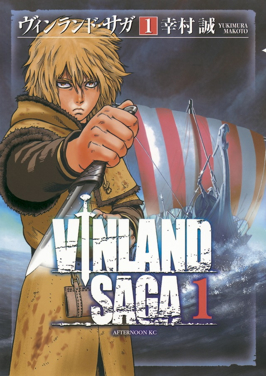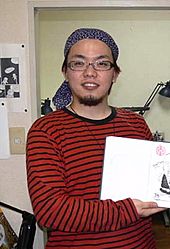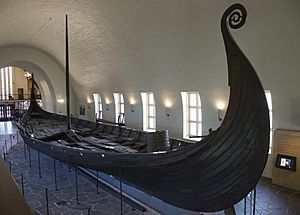Vinland Saga (manga) facts for kids
| Vinland Saga | |

First tankōbon volume cover (Afternoon edition), featuring Thorfinn
|
|
Quick facts for kids ヴィンランド・サガ(Vinrando Saga) |
|
|---|---|
| Genre |
|
| Manga | |
| Written by | Makoto Yukimura |
| Published by | Kodansha |
| English publisher | |
| Demographic | Shōnen, seinen |
| Imprint |
|
| Magazine |
|
| Original run | April 13, 2005 – ongoing |
| Volumes | 27 |
| Anime television series | |
|
|
Vinland Saga (Japanese: ヴィンランド・サガ, Hepburn: Vinrando Saga) is a Japanese story told through drawings, called a manga. It's a historical tale written and drawn by Makoto Yukimura. The story is about Vikings and their adventures.
The manga was first published in a magazine for boys called Weekly Shōnen Magazine. Later, it moved to a magazine for young adult men, Monthly Afternoon. As of June 2023, there are 27 collected books of the story. Vinland Saga is also available in English.
The story mixes real history with made-up events. It follows a character named Thorfinn. He starts as a young man seeking revenge. But he slowly changes into a peaceful person. At the same time, the story shows the rise of King Canute. His journey is very different from Thorfinn's.
The creator, Makoto Yukimura, was inspired by a real king, Olaf Tryggvason. He wanted to write a story about slavery. However, his editor suggested making Thorfinn a Viking instead. Yukimura agreed because he wanted Thorfinn to understand the harm caused by Viking actions. Thorfinn's journey to find a peaceful land called Vinland is a big part of the story. He wants a place where everyone can live together.
Vinland Saga has been very popular. By August 2022, over 7 million copies were in print. It won important awards in Japan in 2009 and 2012. An anime TV show based on the manga started in 2019. A second season came out in 2023. Many people praise the manga for its exciting action and calm moments. They also love Yukimura's artwork.
What is Vinland Saga About?
Where and When the Story Happens
Vinland Saga mainly takes place in England in the year 1013 AD. At this time, the Danish King Sweyn Forkbeard had taken over most of England. As King Sweyn gets older, his sons, Prince Harald and Prince Canute, argue about who will rule next. The story uses details from real historical writings. These include The Flateyjarbók, The Saga of the Greenlanders, and The Saga of Erik the Red.
The Main Story
In 1013 AD, a young man named Thorfinn works for a group of warriors led by Askeladd. Thorfinn wants to fight Askeladd and get revenge for his father Thors' death. Thors was killed by Askeladd's group on a trip to England.
Askeladd's group works as fighters for King Sweyn. They join the Danish invasion of London. Thorfinn's uncle, Thorkell the Tall, who fought with Thors, is also there. When Thorkell captures Prince Canute, Askeladd's group also takes the prince. They plan to sell him for money.
But Askeladd changes his plan. He wants to protect his mother's homeland, Wales, from being invaded. He is a descendant of the legendary Artorius. Askeladd ends up sacrificing himself. He kills King Sweyn during a meeting, pretending to be crazy. This allows Prince Canute to take over England without problems. Thorfinn is shocked and tries to attack King Canute. But Thorkell stops him. Thorfinn is then forced to become a slave.
One year later, Thorfinn works on a farm. The farm owner, Ketil, treats his slaves well. Thorfinn becomes friends with another slave named Einar. Einar helps Thorfinn appreciate his life. With Einar and Ketil's father, Sverker, Thorfinn starts to let go of his sad past.
By this time, Canute has become King of both England and Denmark. He tricked his brother Harald to gain power. Canute then plans to take over Ketil's farm. He tricks Ketil's sons into giving him a reason to attack. Ketil's men are easily defeated by Canute's strong warriors. Thorfinn talks to Canute. He tries to convince the king to leave the farmers alone. Canute sees that Thorfinn has changed and become peaceful. So, Canute gives up his claim to the farm.
When their friend Arnheid is badly hurt by Ketil, Thorfinn remembers his father's words. His father spoke of the peaceful lands of Vinland. Thorfinn and Einar decide to go there together. They are set free from slavery. They leave with Leif Erikson, an old friend of Thors, to sail back to Iceland.
After seeing his family again, Thorfinn shares his plan to settle in Vinland. To pay for their trip, Thorfinn, Leif, Einar, and Leif's adopted son, Thorfinn "Bug-Eyes," plan to sell narwhal horns in Greece.
Later, their group grows. Gudrid, an Icelandic girl running from a marriage, joins them. They also find a baby boy named Karli and a dog on the Faroe Islands. Hild, whose father was killed by Thorfinn, also joins. She holds a grudge against Thorfinn.
After a fight with some warriors, the group is captured. They end up working for Thorkell. Thorfinn continues his journey with his friends. They lead away assassins while the rest of the group escapes. They meet Captain Vagn, who leads a rebel group. Vagn wants to take power from Floki. The remaining men from Vagn's group join Thorkell. Thorkell defeats Floki and captures him.
Thorfinn is briefly made leader of the warriors. He follows King Canute's orders to break up the warrior group. He also spares Floki from being executed. Free from the Vikings, Thorfinn's group continues their journey.
Two years later, Thorfinn's group returns to Iceland. They have money from selling narwhal horns. Thorfinn and Gudrid get married and raise Karli as their son. With help from Halfdan, Thorfinn starts to gather a crew to settle in Vinland. Thorfinn creates a peaceful place where weapons are not needed. He clears part of the forest and successfully grows wheat. He and his friends also make peace with the native Mi'kmaq people. The Mi'kmaq see them as peaceful settlers.
How Vinland Saga Was Made
The manga artist Makoto Yukimura created Vinland Saga. He first thought about making the main character, Thorfinn, a slave. Even as a slave, Thorfinn would face challenges and reach his goals. Yukimura was inspired by King Olaf Tryggvason. This king lost his throne but managed to get it back.
Yukimura wanted Thorfinn to learn about unfair treatment and human suffering. He said Thorfinn doesn't have special skills or a strong body. To make him stand out, Thorfinn was written to experience a lot of pain. Thorfinn's look changes over the story, but Yukimura carefully wrote his feelings.
However, his editor wanted Thorfinn to be a Viking. Yukimura agreed. He wanted Thorfinn to understand the bad things Vikings did later in the story.
Yukimura started Vinland Saga in April 2005. It was in Weekly Shōnen Magazine. In October 2005, it moved to Monthly Afternoon. This change happened because Yukimura found it hard to draw a weekly series. He sometimes works 18 hours a day. He creates and sends one page to the publisher every day. He believes many people want to draw manga, which leads to high-quality stories.
When he started, Yukimura thought the series would take 10 years to finish. Later, he estimated 14 years. He thought there would be 20 volumes, but this number grew to over 22. Yukimura found it hard to plan the story. From chapter 168, he started drawing digitally because of the COVID-19 pandemic.
The series is split into four main parts. The first three are "War," "Slave," and "Eastern Expedition." The fourth and final part doesn't have a special name. In November 2019, Yukimura said the manga entered its final part. This part will be long and take "several years to write."
What Inspired the Creator
Yukimura was inspired by Viking anime he watched as a child. He found their culture new and interesting. In 2003, Yukimura traveled to Norway and Scandinavia to research Vikings. It was hard because of language differences. He said the Oseberg Ship was the most beautiful ship he had ever seen.
Yukimura compared Vikings to Japanese pirates, not samurai. He felt Vikings were more open about their feelings. Samurai were quieter and followed their masters or their own honor. Yukimura also visited Denmark, Iceland, France, Britain, and Canada for research. He even made models to make sure his drawings were realistic.
While Vikings are often seen as heroes, Yukimura wanted to show the harsh truth of their time. Thorfinn always looked serious in the first part of the story. He felt bad for his actions in the next part. Thorkell, another character, was made more funny to make battles more enjoyable to draw.
Yukimura's editors told him not to draw Canute with a beard. They thought it would make him less popular. But Yukimura disagreed, saying men in that era had beards. Thorfinn shaves his beard as an adult. Yukimura didn't want him to look too strong.
Yukimura learned about the real-life Thorfinn from a book. Since there wasn't much historical information, Yukimura could imagine parts of his life. He felt Thorfinn's growth with Askeladd was well done. Askeladd became a complex character. Yukimura said most characters Thorfinn meets help him. Askeladd is different, being both a teacher and an enemy.
Parenting is a common idea in the series. Askeladd guides the young Thorfinn. Einar and Thorfinn also have a complex relationship. One of Yukimura's main ideas is how revenge affects people. Canute was created to be different from Thorfinn. He shows that people have different values.
Many characters are based on real people. The historical Leif Erikson was a famous Norseman. But Yukimura imagined him as a weak warrior who became a strong adventurer. Yukimura noticed most characters in the series are male. Female characters often die or don't appear much. Gudrid is an exception. She is based on a real historical figure who was important to the real Thorfinn. Yukimura tries to stay true to this. Hild, a hunter seeking revenge, reminds Thorfinn of his past sins.
The final part of the story is set in Vinland. It features the Mi'kmaq people. The drawings of Mi'kmaq characters and culture were made with help from experts. The Miꞌkmaq language was also used with help from a linguist. This final story part is based on real events. Thorfinn meets the native people of Vinland.
Important Ideas in the Story
In a 2008 interview, Yukimura said he wanted to make a series about "strength and justice." He was inspired by the manga Fist of the North Star as a boy. Yukimura also said people should have ideals to live a good life.
He wrote the slaves as the opposite of the strong Vikings. Slaves had no power to protect themselves. Yukimura believed that slaves should have ideals, and readers should too. When he wrote Planetes, he struggled with themes of love and life. He felt he was too young then. So, he decided to explore these ideas again in Vinland Saga.
The series has a lot of violence from Vikings. But Yukimura says he hates violence. He had to change his modern ideas about right and wrong to write the story. Vikings were admired for their strength. But they were also betrayed by their own friends. After many violent stories, Yukimura wants to focus on healing and forgiveness.
Yukimura's worries during the Cold War and after the September 11 attacks influenced Thorfinn. Thorfinn is hurt by his actions as a Viking. He decides to find Vinland to create a place where people of all backgrounds can live peacefully.
How Vinland Saga Was Published
Vinland Saga is written and drawn by Makoto Yukimura. It first appeared in Kodansha's Weekly Shōnen Magazine from April to October 2005. Then, it moved to Kodansha's Monthly Afternoon magazine. This started in December 2005.
Kodansha has collected the chapters into individual books called tankōbon. The first two books were re-released after the magazine switch. As of June 2023, 27 volumes have been published.
Kodansha USA publishes the series in English. They release it in special two-in-one hardcover editions. The first English volume came out in October 2013. By December 2022, thirteen volumes were out. Kodansha USA also announced a larger, three-in-one hardcover edition.
TV Show Version
An anime TV show based on Vinland Saga was announced in March 2018. Wit Studio animated the first season. Shūhei Yabuta directed it. The show had 24 episodes and started in July 2019.
Amazon streams the series worldwide on Prime Video. Sentai Filmworks released the series for home viewing. It included a new English voice-over. The show also became available on Netflix and Crunchyroll in July 2022.
In July 2021, a second season was announced. Shūhei Yabuta returned as director. MAPPA animated the second season. It started in January 2023 and also had 24 episodes. The second season was streamed globally on Netflix and Crunchyroll.
Other Stories and Books
Yukimura drew a short, seven-page comic that mixed Vinland Saga with the Assassin's Creed Valhalla video game. This was put on Ubisoft's website in October 2020. A helpful book called Vinland Saga Official Guidebook was released in July 2019.





